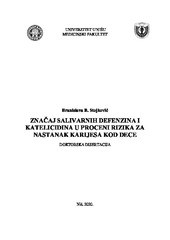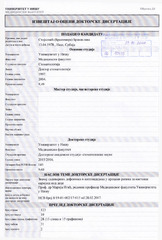Приказ основних података о дисертацији
Značaj salivarnih defenzina i katelicidina u proceni rizika za nastanak karijesa kod dece
| dc.contributor.advisor | Igić, Marija | |
| dc.contributor.other | Tričković Janjić, Olivera | |
| dc.contributor.other | Jevtović Stoimenov, Tatjana | |
| dc.contributor.other | Ivanović, Mirjana | |
| dc.contributor.other | Kostić, Miloš | |
| dc.creator | Stojković, Branislava | |
| dc.date.accessioned | 2021-06-25T13:57:59Z | |
| dc.date.available | 2021-06-25T13:57:59Z | |
| dc.date.issued | 2021-01-19 | |
| dc.identifier.uri | http://eteze.ni.ac.rs/application/showtheses?thesesId=8220 | |
| dc.identifier.uri | https://fedorani.ni.ac.rs/fedora/get/o:1717/bdef:Content/download | |
| dc.identifier.uri | http://vbs.rs/scripts/cobiss?command=DISPLAY&base=70052&RID=32998409 | |
| dc.identifier.uri | https://nardus.mpn.gov.rs/handle/123456789/18420 | |
| dc.description.abstract | The study aimed to examine the significance of human α defensin 1 (HNP-1), human β defensin 2 (hBD-2) and human cathelicidin (LL-37) of unstimulated saliva as caries risk biomarkers in childhood. A one-year, prospective study which included preschool children (N=250) and early adolescents (N=213) was conducted. Having interviewed the mothers/guardians of the subjects, socio-demographic data, data on the health status, oral hygiene, and dietary habits of the subjects were collected. The clinical examination recorded the state of oral hygiene and dental health of the subjects. Unstimulated saliva was sampled to determine its pH value, and in 85 preschool children and 85 early adolescents to determine the salivary level of HNP-1, hBD-2 and LL-37 using commercial ELISA kits. After 12 months, a repeated examination recorded the state of the dental health of the subjects, along with the determination of the annual caries increment. A cross-sectional study showed that the concentration of the tested HNP-1, hBD-2, LL-37 correlated with the age of the children, and the salivary pH but not with the caries presence, so the study did not determine their significance as caries risk indicators. In preschool age, this significance was shown by gender (p=0.021), the age of the mother (p=0.028), length of breastfeeding (p=0.042), frequency of carbohydrate intake (p=0,009), and values of the oral hygiene index (p=0.042), that is, the level of education of the mother (p<0.001) and the father (p=0.002), oral hygiene index values (p<0.001), frequency (p=0.029) and length of performing oral hygiene (p<0.001) in early adolescence. The logistic regression analysis showed that the analysed peptides were not recognized as reliable caries predictors in childhood. The multivariate model showed that the most significant caries predictors in preschool children were the oral hygiene index (p=0.005) and the absence of dental visits (p=0.014), compared to gender (p=0.001) and variables related to oral hygiene (p=0.044) in early adolescence. Determining the importance of salivary defensins and cathelicidin as caries risk biomarkers in childhood is complex, since their concentration may be related to certain factors, such as age and salivary pH which the study found, and probably with many salivary components that may interact with these peptides. Therefore, it could be considered justified to use a multimarker approach in determining the importance of defensins and cathelicidin as caries risk biomarkers in children, rather than analyzing their efficacy as a solely risk biomarkers. Based on the results of the study, socio-demographic characteristics and oral-hygiene habits remain important caries risk factors in childhood, suggesting the importance of the mechanical control of dental biofilm as a central caries preventive measure. | en |
| dc.format | application/pdf | |
| dc.language | sr | |
| dc.publisher | Универзитет у Нишу, Медицински факултет | sr |
| dc.rights | openAccess | en |
| dc.rights.uri | https://creativecommons.org/licenses/by-nc-nd/4.0/ | |
| dc.source | Универзитет у Нишу | sr |
| dc.subject | Karijes | sr |
| dc.subject | Caries | en |
| dc.subject | Defensins | en |
| dc.subject | Cathelicidin | en |
| dc.subject | Saliva | en |
| dc.subject | Caries risk biomarkers | en |
| dc.subject | Children | en |
| dc.subject | Defenzini | sr |
| dc.subject | Katelicidin | sr |
| dc.subject | Pljuvačka | sr |
| dc.subject | Karijes rizik biomarkeri | sr |
| dc.subject | Deca | sr |
| dc.title | Značaj salivarnih defenzina i katelicidina u proceni rizika za nastanak karijesa kod dece | sr |
| dc.type | doctoralThesis | en |
| dc.rights.license | BY-NC-ND | |
| dcterms.abstract | Игић, Марија; Тричковић Јањић, Оливера; Костић, Милош; Јевтовић Стоименов, Татјана; Ивановић, Мирјана; Стојковић, Бранислава; Значај саливарних дефензина и кателицидина у процени ризика за настанак каријеса код деце; Значај саливарних дефензина и кателицидина у процени ризика за настанак каријеса код деце; | |
| dc.identifier.fulltext | https://nardus.mpn.gov.rs/bitstream/id/72212/Doctoral_thesis_29075.pdf | |
| dc.identifier.fulltext | https://nardus.mpn.gov.rs/bitstream/id/72213/Stojkovic_Branislava.pdf | |
| dc.identifier.rcub | https://hdl.handle.net/21.15107/rcub_nardus_18420 |



